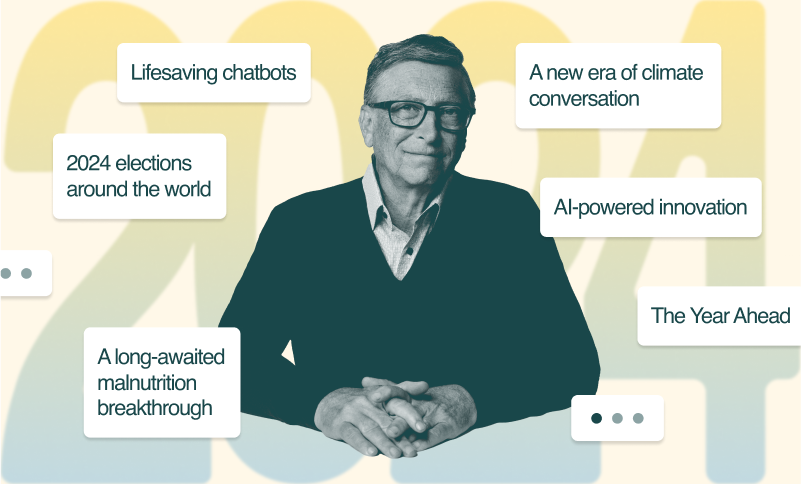Today, about three quarters of people worldwide have an account at a financial institution or through a mobile money provider.
Wind and solar power generation is expanding around the globe at record rates, allowing more people to get their electricity from clean, renewable sources than ever before. This is great news.
And here’s better news: We can do even more. By investing in energy innovations, we can build on the progress we’ve made deploying current technology like renewables, which will help accelerate the transition from fossil fuels to a future of reliable and affordable carbon-free electricity.

This would be an incredible achievement and the most important step we can take to prevent the worst impacts of global warming.
Here’s why: While electricity generation is the single biggest contributor to climate change—responsible for 25 percent of all greenhouse gas emissions and growing every day—it’s an even bigger part of the solution. With clean electricity, we can do more than light our homes and power our grid. We’ll unlock a source of carbon-free energy to help power the sectors of the economy that produce the other 75 percent of greenhouse gas emissions, including transportation, buildings, and manufacturing. Think electric cars and buses; emission-free heating and cooling systems in our homes and businesses; and energy-intensive factories using more clean power to make products.
So, what will it take to reach the goal of zero carbon electricity generation?
We must solve two challenges. The first challenge will come as no surprise. We need to do more to harness the power of the sun and wind. And thanks to falling prices for solar panels, wind turbines, and other technologies, deploying renewable energy systems is more affordable than ever before.
The second challenge is probably less obvious and more difficult. We need big breakthroughs in technologies that will allow us to supply the power grid with clean energy even during windless days, cloudy weather, and nighttime.
Usually, you back up renewable sources with fossil fuels like natural gas that can quickly and reliably provide power when it’s needed. To reach zero carbon emissions, however, we need to find a way to use more clean energy sources as a backstop.
While I wish there could be a single, magic bullet solution to this problem, there isn’t one right now. What will be required in the years ahead is a diverse and flexible mix of energy solutions—a Swiss army knife of energy tools—to support a future of renewable energy generation to meet our needs. Some of these solutions already exist. Others will require more innovation. All can help us make the transition to low-cost, carbon-free power. This is something a growing number of states across the U.S. are recognizing as they adopt 100 percent carbon-free standards for electricity.
Here are three key solutions we’ll need for the transition to clean electricity:
- Improved energy storage systems: The sun and the wind are incredible energy sources. Finding ways to store that energy to use after the sun sets and the wind stops blowing is a big challenge we need to solve. We do have ways to store energy for a matter of hours—like lithium ion batteries—that are becoming cheaper every year.
What we don’t have are reliable and widely useable ways to store renewable energy sources for days, weeks, or months. We need to be prepared for seasonal changes (when we have short days during the winter) or worse case scenarios when there are long periods of cloud cover or no wind for weeks or months.
Fortunately, there’s a lot of creative thinking to solve these challenges. I am an investor in a group called Breakthrough Energy Ventures (BEV) that is backing a number of companies exploring ways to store energy. Here are some key areas of innovation:- Hydro: The most common form of energy storage today is pumped hydro, which uses electric motors to pump water uphill to a reservoir. When the water is released from the reservoir, it flows downhill and generates electricity through hydroelectric turbines. The challenge with this approach is that it only works in geographies with high elevations and low elevations. A new company called Quidnet Energy, supported by BEV, is trying a different approach that is lower cost and can be built in flat areas. Quidnet’s system uses renewable energy to pump water into underground wells, creating huge amounts of pressure. When that energy is needed, the pressure is released, pushing the water up the well and through a turbine, generating electricity.
- Batteries: Lithium-ion batteries, like you would find in a laptop, mobile phone or electric car, are one of the fastest growing storage solutions. But they work best for short-duration storage. Form Energy, a BEV-backed company, is creating a new class of batteries that would provide long-duration storage at a lower cost than lithium ion batteries.
- Thermal storage: Thermal-powered storage technologies have the potential to offer a flexible and reliable power backup for the grid. One of the most effective ways to store heat is in molten salt. Malta, Inc., a BEV company, has developed a molten salt thermal technology that operates like a heat pump. Renewable energy stored as heat in molten salt. In discharge mode, the system works as a heat engine, using heat to produce electricity.
- Zero-carbon fuels: There are other exciting potential storage solutions as well, including zero-carbon fuels produced with wind and solar power that can be turned back into electricity or used to decarbonize other sectors.
- Carbon capture and storage and nuclear: I often hear that lower cost solar and wind power along with the emerging breakthroughs in energy storage mean that these sources will be enough to get us to a carbon-free power grid. But because the world must balance the need to eliminate carbon emissions with economic growth, we should also consider what solutions would be most affordable. A recent study from researchers at MIT found that supporting renewable energy with a mix of clean energy solutions—including nuclear and carbon capture and storage (CCS)—would make carbon-free electricity up to 62 percent cheaper than using renewables alone.
Nuclear power is already a source of carbon-free electricity, producing about 10 percent of the world’s power. It would also serve as a very reliable source of clean energy to complement renewables. But high costs and safety concerns have slowed the growth of nuclear power. With innovations in nuclear power we can create a new generation of nuclear energy that would be safer, produce less waste, and be lower cost.
There are several nuclear technologies that should be explored. One of them, a company I helped start called TerraPower, uses an approach called a traveling wave reactor that is safe, prevents proliferation, and creates very little waste. To make these innovations a reality, we need governments—especially the U.S.—to step up and commit new funding for nuclear energy research and demonstrate that there is a future for nuclear energy.
Another way we can get zero-carbon electricity is carbon capture, utilization, and storage, which separates and permanently stores CO2 pollution from an energy plant’s exhaust to keep it out of the atmosphere. This technology is especially important in places where there isn’t good renewable energy potential, or where it would be too costly to retire and replace existing power plants. - High-voltage, long-distance transmission lines: Renewable power resources like wind and solar are often located far from the cities or industrial areas where energy demand is the greatest. Connecting our renewable energy supply with demand will require us to build transmission lines that can handle large amounts of power over very long distances. High-voltage direct current (HVDC) transmission technology—as opposed to the alternating current power lines most electric grids in the U.S. use today for transmission—would help us integrate renewable energy into our world’s power supply. Expanding HVDC lines, however, will not only require new investments in our power grids, but also supportive national and local policies to support their construction. Research and development at U.S. Department of Energy national laboratories like the Pacific Northwest National Laboratory and the National Renewable Energy Laboratory is helping lay the groundwork for how we can design, build, and operate a 21st century grid.
It’s easy to be overwhelmed by climate change and what to do about it. Global greenhouse gas emissions, for example, went up again last year—another reminder that we must act quickly if we want to prevent the worst-case scenarios of our warming planet.
Still, as I learn about all the new ideas to address this challenge, I am optimistic that with the right mix of solutions we can deploy right now and new innovations we can build a path to a carbon-free future.





